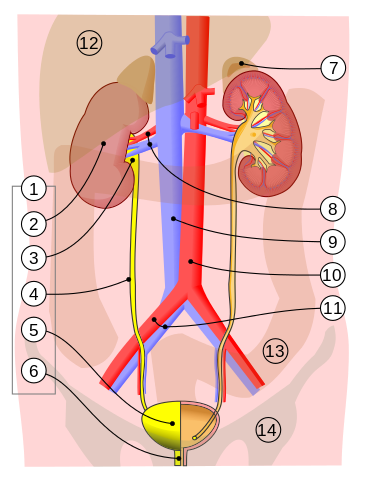Fluid Station 1.2
Communications Module
Fluid Systems in Health Fields
I.V. Therapy- How it Relates to Fluid Balance
 ttps://commons.wikimedia.org/wiki/File:Urinary_system.svg#/ media/File:Urinary_system.svg |
- Module Goal: To apply medical terms and concepts related to the balance of body fluids.
- Materials Required: Computer with fast Internet connectivity.
- Applied Objectives: In completing this unit, you will.
- Interpret and analyze reading passages related to the fluid balance in the body.
- Identify the roots, prefixes, and suffixes for medical terms.
- Apply new medical terms in writing.
- Develop reading fluency through recordings of different kinds of passages.
- Write definitions and summaries.
- Write four different kinds of sentences.
- Apply the skill of paraphrasing in writing.
- Analyze cause and effect in problem solving.
- Pre-requisite knowledge- 6th grade reading level.
- Applied Terminology: Many new medical terms are introduced throughout this module. You will learn their meaning by breaking them into their parts, and then practice using them in different forms of sentences.
- Evaluation: Activities submitted in this module will be evaluated by the number of items completed, by the percentage of correct answers, and by rubrics. A rubric is a table that shows you what you are being graded on. A rubric states exactly what is expected of you at different levels.
Note on Grading:
You will receive three grades in each of your communications modules: (1) for a project graded by a rubric; (2) for an assigned activity graded for completion and correctness; and (3) for completing and submitting at least five activities from the activities labeled with the icon representing "5."
![]() Activity graded by the % of correctness of your work
Activity graded by the % of correctness of your work
![]() Activity graded by the rubric
Activity graded by the rubric
![]() Activities from which you can choose five to submit
Activities from which you can choose five to submit
INTRODUCTION
Body fluids need to be balanced to maintain good health.
![Description: C:\Documents and Settings\Deb\Local Settings\Temporary Internet Files\Content.IE5\OCMQCMFE\sweat[1].jpg](images/dehydrated.gif)
In this station’s lab, you discovered what I.V. Therapy is, how it works, and how it relates to fluid balance in the body. You learned about dehydration, how to determine unhealthy fluid levels in the body, and how to use I.V. therapy to restore fluid balance.
Think about the following questions and discuss them with your coach or other students in the program:
- Have you had any personal experience with dehydration? What happened? Did the person with the dehydration need to be put on an I.V.?
- How else can a person rehydrate their body?
- If your car ran out of oil, what would happen to the engine? How could you fix the problem?
- How is the word rehydrate different than dehydrate? What does the prefix re mean? What does the prefix de mean?
In the next module, you will practice reading and writing activities.
__________________________________________
Links to Station 1.2. Modules
Lab Intro | Lab Presentation and Practice | Communications Intro| Communications Presentation and Practice| Math